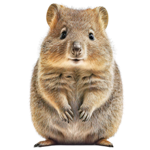History of... Quokka
Name: Quokka
Scientific Name:
Setonix brachyurus
Family:
Macropods
Conservation Status:
Vulnerable (Population decreasing)
Habitation:
They live in long grasses and shrubs, where they make pathways they move along to find food or to escape if disturbed.
Global Location:
Australia
Discovery:
First discovered in 1696
During the Pleistocene period, quokkas were more abundant and lived in open landscapes. When Europeans arrived in Australia, they introduced new animal species, such as red foxes, cats and dogs. Some of which became predators to the quokkas. This caused them to move to islands and forests where there were less predators and more vegetation.
In 1696 Willem de Vlamingh thought he spotted a giant rat. He named the island Rattennest which means Rat's Nest in Dutch. Over the years the name was adapted to Rottnest Island.
The is a small macropod that is about the size of a domestic cat. Like other marsupials in the macropod family, kangaroos and wallabies, the quokka lives on vegetation and is awake mainly at night.
It has thick grey-brown fur, short rounded fluffy ears and a tail. A quokka weighs 2.5 to 5.0 kg (5.5 to 11 lb) and is 40 to 54 cm (16 to 21 in) long with a 25 to 30cm long (9.8 to 12 in) tail.
Their movements resemble a bounding gait interspersed with hopping. They are able to climb trees to reach a food source.
Quokkas mature at about eighteen months of age. On the mainland, female Quokkas are able to produce about seventeen offspring over a lifetime, with two joeys being born each year. On Rottnest Island, with a shorter breeding season, Quokkas usually only give birth to one offspring per year.
The young will remain in the pouch for about six months. After the joey leaves the pouch the female will continue to provide milk for around two more months. Joeys are usually weaned by eight months of age.
The quokka is known to live for an average of 10 years.
They sleep in Acanthocarpus plants using the spiky leaves for protection and hiding.
Like most marsupials quokkas eat many types of vegetation including grasses, sedges and leaves.
Despite being numerous on the small, offshore islands, the quokka is classified as vulnerable. On the mainland, where it is threatened by red foxes, cats, and dogs. Human impacts of logging, agricultural development, housing expansion and clearing of swamplands have further reduced their habitat. All of which have contributed to the reduction of their numbers.
Some zoos have quokkas.
There is estimated to be around 15,000 quokkas living wild. An estimated 4,000 quokkas live on mainland Australia, with the rest living on some of the nearby islands. The largest wild population live on Rottnest Island. 


